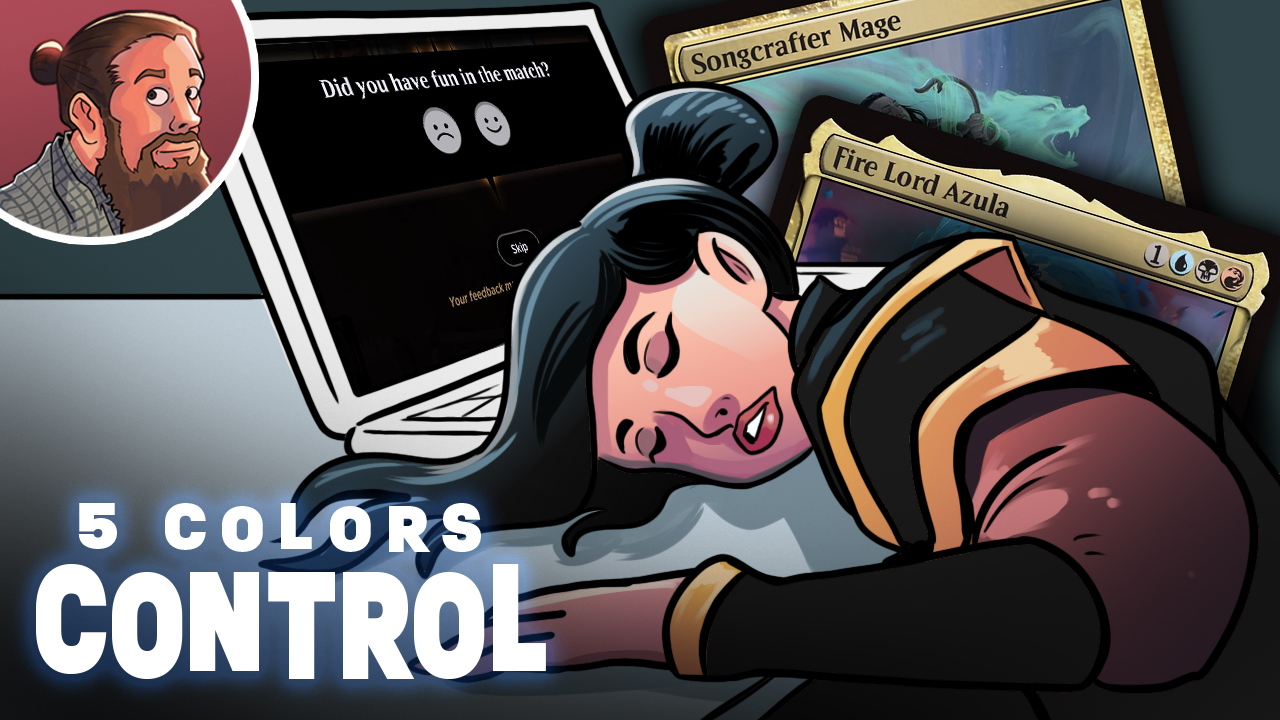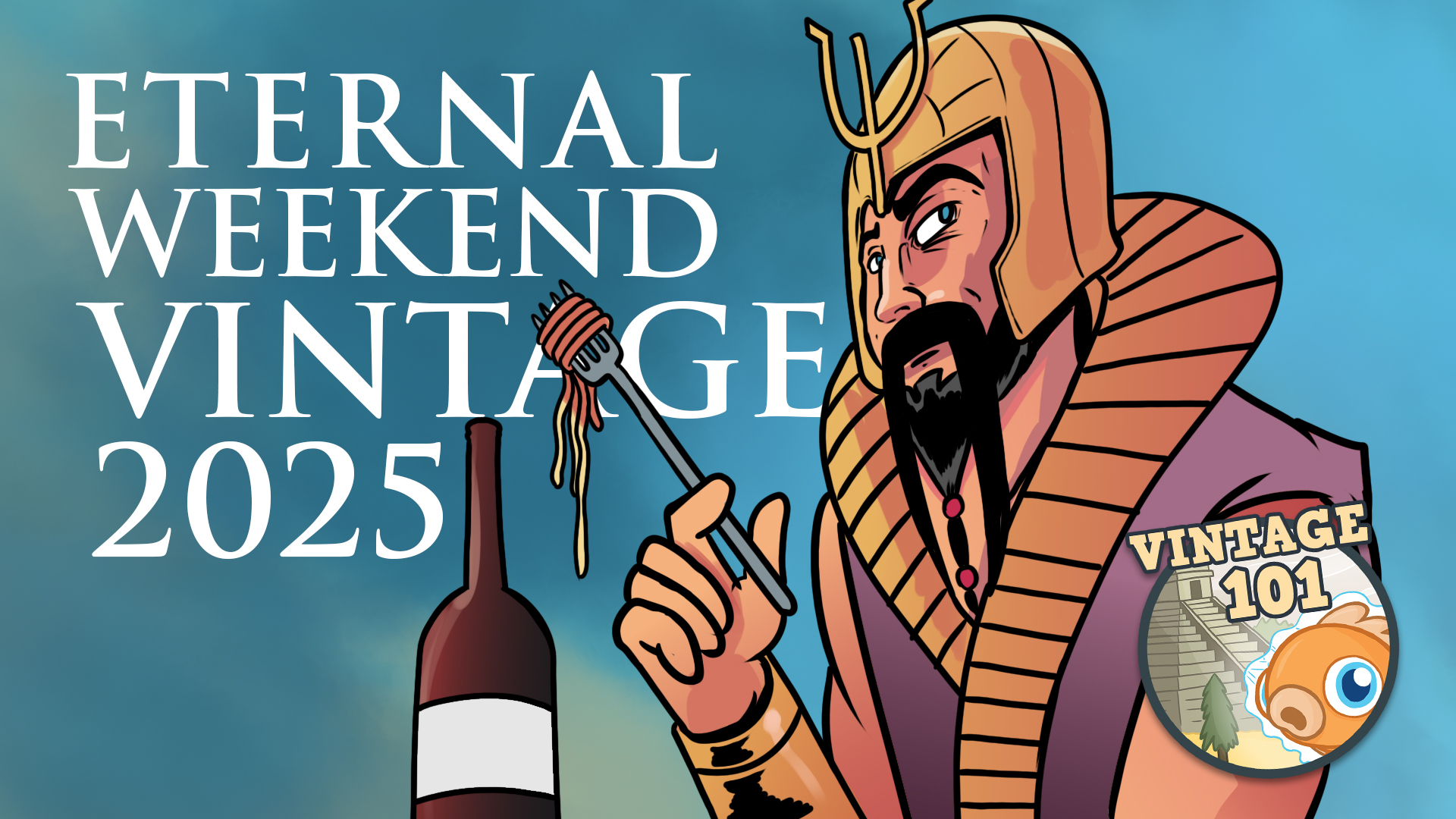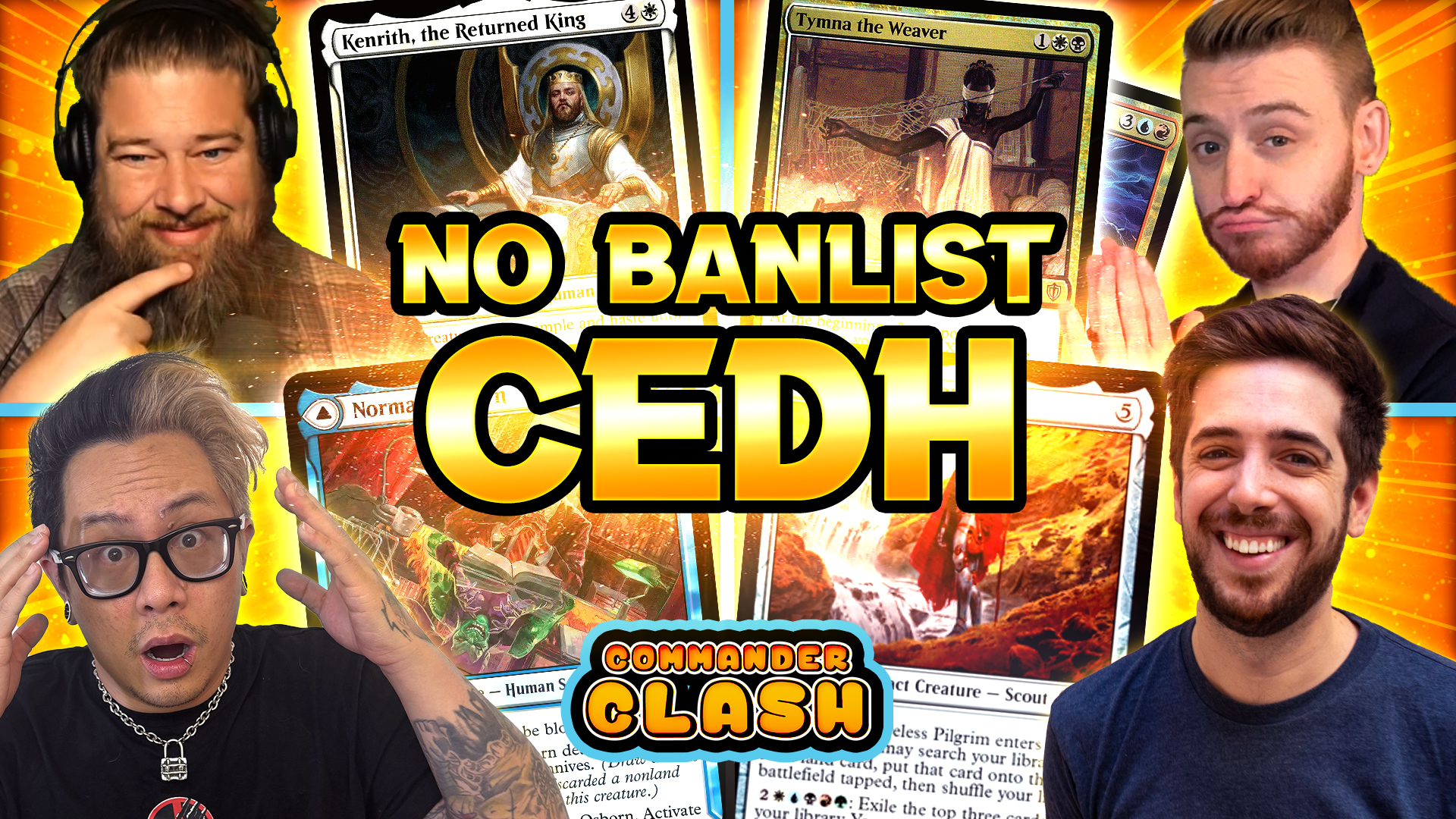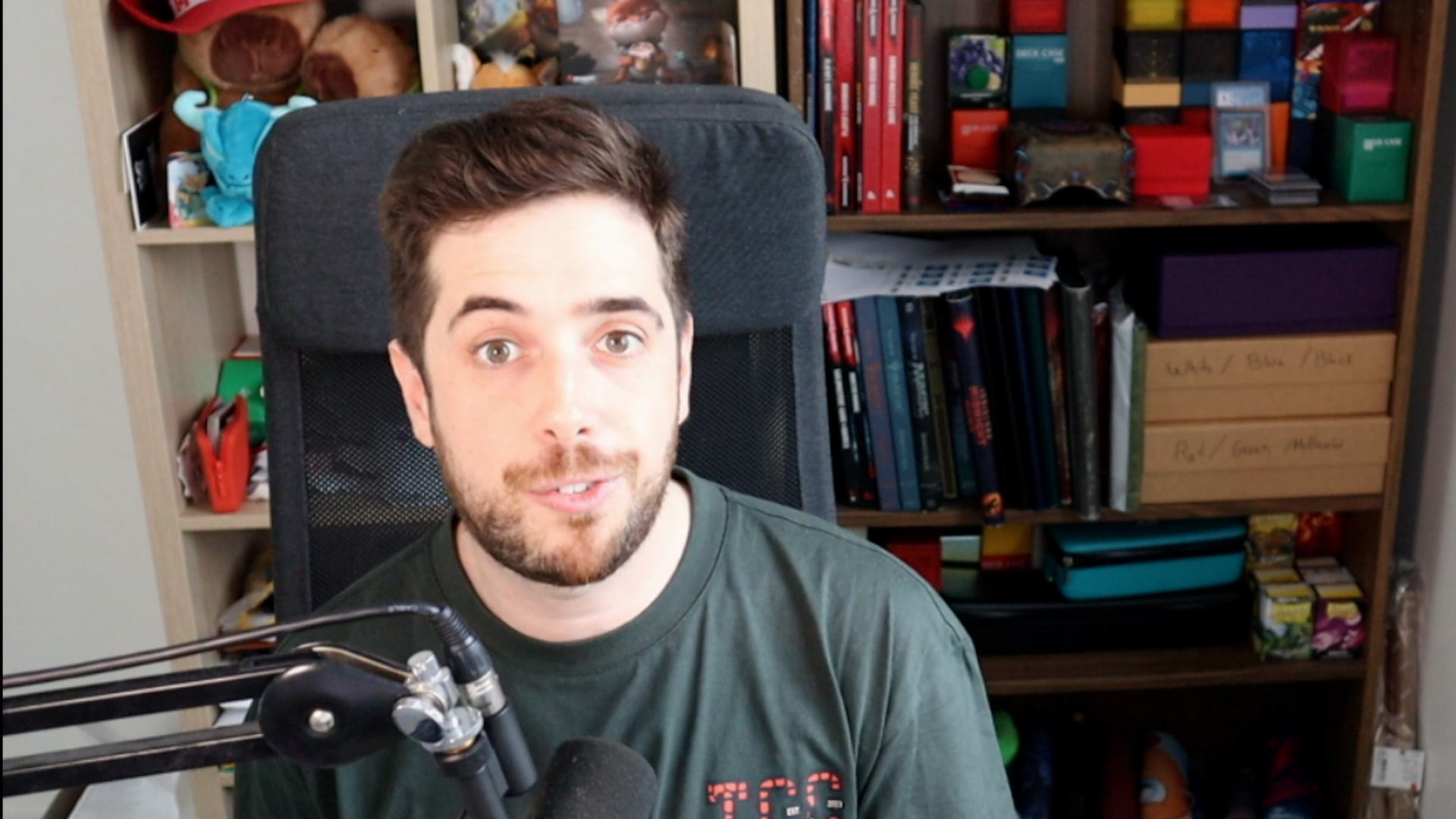Spread 'Em: Understanding the Spread in Standard and Modern
Whenever I hear the the word "spread" in relation to magic, the first thing that comes to my mind is Gerry Thompson's 2009 deck "Spread 'Em." According to Gerry it got its name when he tried to convince David Ochoa and Wrapter that they should be playing Spreading Seas and Convincing Mirage to beat the Jund menace in standard, when LSV suddenly burst into the room and yelled "Spread 'Em!"

Admittedly, this 5-year old standard deck has very little financial relevance today, however spread has an important meaning in regards to card prices, which is what we will be talking about today.
Spread in MTG Finance
In the world of MTG finance, "the spread" has nothing to do with LSV, GerryT, or Jund. Instead, it refers to the difference between the lowest price you can buy a card for and the highest price you can sell a card for. Let's use Sylvan Caryatid, currently the fourth most played card in standard as a four-of in 39 percent of decks as an example.
Right now, the cheapest copy of Sylvan Caryatid from a vendor is $12.72. The best buy price is $8.01. This means there is a $4.64 difference between buy and sell prices. While knowing this dollar amount is fine, it actually means very little because it does not help us compare cards of different prices (for instance, Underground Sea has a spread of nearly $100). So what we really are looking for is the percent difference between buy and sell prices, which for Sylvan Caryatid is 36.32 percent.
The 36 percent spread on Sylvan Caryatid is a bit lower than the rule of thumb that I've always heard regarding the spread - that vendors pay about 40 percent of their sell price. The thing that bugged me about this number is that I never really knew where it came from. Is the 40 percent spread something that we can actually hang our hats on? Or is it an old wives tale that has circulated through the finance community?
While it might not be apparent quite yet, the spread is one of the best tools we have to judge the supply and demand of any specific card and to predict price increases and decreases. But to be able to use the spread to our advantage, we need to have a baseline, a "normal" range, so we can identify cards that fall outside this range and try to figure out what is going on. If you look over historical spreads, you will find that cards tend to regress to the mean. For instance, a card with a very high spread will either increases in buy price, or decrease in sell price, until it gets back in the "normal" range. A card with a very low spread will do the opposite - either increase in sell price, or drop in buy price.
Knowing just how a specific card with an out of the ordinary spread will react is not as quite as easy, and requires looking at other variables like historical prices and spread, decklists, and so forth. However when a spread is out of whack, it's a pretty good bet that something is going to happen to get it back in line - it's just a matter of figuring out which of the two options is more likely.
Anyway, for any of this to matter we need to know what the "normal" or baseline spread is for various grouping of cards. To do this, I crunched the numbers. Be warned, the rest of this article is going to contain a lot of statistics and numbers, but they are all necessary to accomplish our goal of computing a baseline spread. All the prices used to calculate the spread are from between 11/09 and 11/12. These prices are not the averages often used for trading, but instead are the actually lowest price you could either purchase a card from or sell a card to a respected dealer.
Spreading Standard
Standard Mythics Baseline:
Currently there are 65 mythic rares in standard with prices ranging from Brimaz, King of Oreskos and Nissa, Worldwaker at about $30 to Hythonia, the Cruel at $0.34. The average lowest vendor sell price of all standard mythics is $6.22, the average highest buy price of standard mythics is $4.20. This means the average spread of standard mythics is $2.02, or 35.48 percent.
There are 13 mythics in standard whose lowest sell price is currently $10 or more. If you calculate the spread on these cards, you find an average of 30.13 percent. If you break down the standard mythics by set, you find things, more or less consistent with Theros block having the lowest average mythic spread at 33.13 percent, and Khans having the highest at 36.99 percent.
Standard Mythics with Highest Spread:
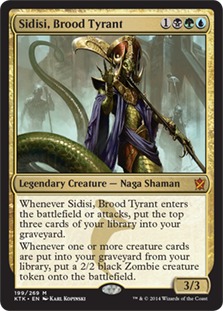


Sidisi, Brood Tyrant currently has a 60 percent spread. If you look over its price history, you will find that over the past week, the amount vendors are willing to pay for the shaman has been cut in half, from $3 to $1.50. However, the price they are willing to sell a copy for has only ticked down by a $0.25. To me this suggests that the sell price of Sidisi, Brood Tyrant is likely to decline - the demand for this card is just currently not there, and by dropping their buylist prices, vendors are trying to avoid getting stuck with a bunch of Sidisi, Brood Tyrants that they paid $3 for but can only sell for $2.50. A decrease in sell prices of between $1 and $1.50 would get Sidisi, Brood Tyrant back into the normal range.
The other two cards are far less interesting financially, simply because they are already very close to bulk mythics, and less expensive cards generally have high spreads. If you are in the market for speculating on inexpensive mythics, you're probably better off looking at the bottom of the barrel with cards like Ugin's Nexus and Hythonia, the Cruel, which are basically as cheap as a mythic can ever be. If you buy in now and they go up over the next couple years, you make money. If they don't, you can't really lose much of anything, since you can always bulk them out.
Standard Mythics with the Lowest Spreads:
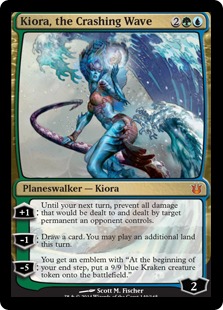


Kiora, the Crashing Wave has the insanely low spread of 2.97 percent. Unfortunately, this is because sell prices have dropped nearly $10 over the past three weeks, while some vendor have yet to drop their buy prices. What this means is that I will be moving my copies of Kiora now (like today) because the buy price is about to drop by a few dollars. Currently, you can buylist out copies to one vendor for only $0.30 less that you can buy from another vendor - this won't last for long. Same deal with Empty the Pits and its 0 percent spread. While most vendors are buying Empty the Pits as bulk, one vendor is buying for another vendor's sell prices. Take advantage while you can.
I feel better about Pearl Lake Ancient. It's currently a bulk mythic with a very non-bulk spread. The difference is, the leviathan actually has a deck, and recently spiked to over $5 for a short period. While I don't think Pearl Lake Ancient is a $5 dollar card, I also do not see it as bulk mythic either. So here, I'm a buyer at $1.19, with the plan of waiting for UB control to spike a tournament to cash out.
Baseline Spread Standard Rares:
For standard rares, I calculated every card with a sell price of $1 or more (cards below $1 throw off the calculations, because you run into a bunch of cards that are purchased at bulk, but sold for $0.49). Here, the spread of all 70 cards comes to 38.87 percent, but this number comes with an asterisk. The 21 standard rares that have a lowest sell price of $5 or greater have a spread of 31.57 percent, which is actually lower than the average spread of standard mythics. The other 49 cards (priced between $1 and $4.99) have a much higher spread - 45.55 percent.
If you break things down by set, you find that KTK has the highest spread (48.33 percent) as the ever increasing supply scares vendors away from offering solid buy prices. Theros, as with mythics, has the lowest spread at 34.54 percent. While I don't have the data to analyze past sets, THS having such low spreads seems to back up the common knowledge that you buy cards from big fall sets during their first winter and sell them the following winter.
I was also curious about lands, since these cards have more demand than any other standard cards. I was a bit surprised to find that the spread of the 25 rare lands in standard is actually higher than for all rares of $5 or more (a grouping that include a fair number of lands) 33.69 percent. The other thing that stuck out about lands is their consistency from set to set and cycle to cycle. KTK fetch lands currently have an average spread of 35.45 percent, with only Theros temples have a higher average spread at a whopping 41.45 percent. The M15 painlands and Journey into Nyx temples come in at 33 percent, while Born of God temples come in the lowest at 27.84 percent, a fact which is not attributable to a single card, as all three BNG temples come in with below average spreads.
Standard Rares - Highest Spreads:



I sent out a tweet Sunday morning letting you know that Nykthos, Shrine to Nyx has a negative spread (you can follow me @SaffronOlive). At the time, you could literally buy from one vendor for $0.21 cents less than you could sell to another vendor. While this opportunity has since passed and I don't want to focus on arbitrage (since it has been well covered by other writers), it is worth keeping an eye out for these type of opportunities. In these cases the inefficiencies of the market are your friend.
It might be a bit unfair to put Urborg, Tome of Yawgmoth and Thoughtseize in the standard section, because their demand in other formats likely plays a role in their mid-teens spread. These cards are different than most of the others on the list because they are not just being purchased by one vendor for an extremely high price, but instead have strong buy prices across the board.
Take Thoughtseize, a true multi-format all-star that is currently standard legal. In this case, at least to me, the abnormally low spread isn't so much out-of-place and awaiting an adjustment, but instead an indicator of the strong demand for the card. Right now, Thoughtseize is probably the one standard card that is most liquid. If you want to turn your Thoughtseize into a twenty dollar bill, you should have no problem. This appeals to vendors as well. It's worth it to pay a bit more (and thereby make a bit less) on Thoughtseize because you know as soon as it come in your shop, it's heading right back out the door, and you're putting a few extra dollars in your pocket. This leads to vendor competing in their buy prices - everyone wants Thoughtseize in stock right now so they fight each other for the copies that are available.
Highest Standard Rare Spreads:



What's the matter with Chord of Calling? You can't buy a copy from a vendor for much less that $4, but no one wants to pay you more that $1 for any copies you have laying around. I just got done talking about how Thoughtseize can maintain a low spread by seeing tons of play in multiple formats - isn't Chord of Calling similar to Thoughtseize?
The answer here is demand. If you look over recent decklists, you find that Thoughtseize is played five times as often in modern and 500 times more often in standard than Chord of Calling. I could even see a good argument that the only reason Chord of Calling is maintaining a $4 sell price is price memory (along with M15 being a comparatively under-opened set). While there is little doubt that card is powerful, it's simply not being played, and while this could change and cause Chord of Calling to spike, I wouldn't bet on it anytime soon.
Utter End is currently overshadowed by Hero's Downfall, which kills almost everything that Utter End does, but in a more mana-efficient and color-efficient way. I expect Utter End to drop a few cents before potentially rebounding post Theros rotation (and maybe even becoming a premier removal spell).
Soldier of the Pantheon is a powerful card without a deck. Its buy price has dropped far more than its sell price over the past month, so I expect that sell price to follow, until the format shifts and Soldier of the Pantheon starts to see more play. Over the past 60 days, he has shown up in only 6 decks - which puts it at a similar level as Boon of Erebos and Windstorm.
Standard Uncommons
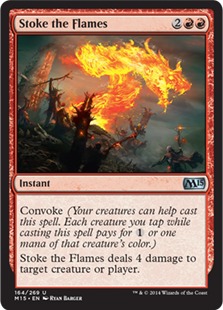

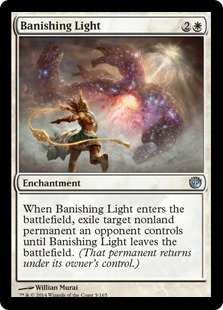
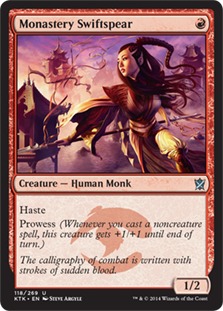
There are only four uncommons in standard that maintain sell prices of more than a dollar: Stoke the Flames, Nyx-Fleece Ram, Banishing Light, and Monastery Swiftspear. With such a small sample size, the average spread of 40.12 really means nothing. Stoke the Flames and Nyx-Fleece Ram both have solid spreads in the mid-20s, while Banishing Light and Monastery Swiftspear have relatively high spreads of just over 50 percent.
While I didn't bother to crunch the number on uncommons less than a dollar, a quick glance suggests that spreads are typically far higher than with mythics or rares. In many cases cards being sold for $0.75 are only being purchased for $0.10. Even hot uncommons resemble bulk rares as far as prices and spreads.
Spreading Modern
Expensive ($20+) Staples:
There are 53 cards in modern sets (a couple are not modern-legal due to bannings) that have sell prices of $20 or more. These cards have an average lowest sell price of $39.58 and an average highest buy price of $26.95. This makes the spread on the most expensive cards in modern 31.85 percent. While this spread is lower than any grouping of standard cards, one of the most interesting things about the spread of expensive modern staples is that it is so consistent. The highest spread is 43 percent, and out of the 53 cards, only two have a spread higher than 40 percent. The lowest spread is 20 percent, and only 3 cards have a spread of under 25 percent. In fact, 44 of the 53 cards have spreads that fall between 25 and 35 percent.





The Zendikar fetch lands provide an interesting case study in the spread. Scalding Tarn has the highest spread of all expensive modern cards, coming in at 43.15 percent. Arid Mesa, Marsh Flats, and Verdant Catacombs have the lowest spreads in modern, at between 20 and 22 percent.
What this suggests to me is that vendors are worried about a reprinting and don't want to be caught holding a bunch of Scalding Tarns that they paid $35 for, but can only sell for $25. On the other hand, it also suggests that vendors don't think the price of the non-blue fetches are going to suffer too much from a reprint, so they are comfortable paying $20ish for Verdant Catacombs, Marsh Flats, and Arid Mesa.
While Zendikar to Onslaught is not a perfect comparison for several reasons, if you look at the prices of cards like Windswept Heath and Bloodstained Mire you can see why vendors are making this bet.
The non-blue Onslaught fetches are actually worth more today than they were two years ago, despite the KTK reprinting. In essence, vendors are betting that if and when the ZEN fetches are reprinted, the original printings of Arid Mesa, Marsh Flats, and Verdant Catacombs will not lose very much of their value. Some standard players will want to play with the original printings, and these less expensive fetches will have increased demand from both from standard and modern. However, Scalding Tarn is just currently too expensive for the Zendikar printing to hold its current price tag with more copies entering the market. While some number of players will pay an extra $10 to get the Zendikar version of Arid Mesa for their deck, far fewer would be willing to pay an extra $30 for an original printing of Scalding Tarn.
Other Modern Rares/Mythics:
Now, I have to admit, there are a ton of rares and mythics in modern, and since I am putting all of this information into spreadsheets, here is my sudo-scientific way to actually get this article published during my lifetime: discounting the 53 cards over $20, and all the cards under $3, I went set by set through all of modern and input the data for every fifth card. While not a true random sampling, using this method has the advantage of including multiple cards from each set, and cards at every price level.
Using this method, we end up with 117 rares and mythics from modern sets with lowest sell prices between $3 and $19.99. This means that are nearly 600 in this group all together. The average sell price of these 117 cards is $8.63, the average highest buy price is $5.68, which makes the average spread 34.05 percent.



I wanted to see if competitive/tournament cards have better spreads than casual only cards, but as far as I can tell, they don't. Cards with the lowest spread include casual only cards like Knight Exemplar at 8 percent, Wound Reflection 11 percent, and Seedborn Muse at 13 percent. In fact, out of all 117 cards, the seven that have spreads of less than 20 percent are all what I would consider casual-only card. On the other hand, all the cards with very high spreads (+50 percent), including Doubling Season, Rune-Scarred Demon, Polluted Bonds, are primarily casual cards as well (other than some white bordered pain lands).


Meanwhile, the spreads on tournament cards is relatively consistent with most falling between the mid-to-high 20's and mid-to-high 30's as far as percentages, much like expensive ($20+) modern rares and mythics. To me this suggest that vendors believe the demand for tournament cards is much more stable than casual cards. While a large vendor always wants to have copies of Birthing Pod on hand, they are alright with buying s bunch of copies of Swarmyard for a respectable price, then dropping their buy price while they wait for the copies to sell. This means the buy price histories of casual cards often resembles some chaotic ocean waves, with big rises and falls, seemingly at random, while tournament cards generally look like a staircase, as prices step up and down depending on the season, the most popular decks, and indicators of demand.
Modern Commons and Uncommons
There are 58 commons and uncommons in modern with sell prices between $2 and $19.99. The average sell price of these 59 cards is $3.87, the average highest buy price is $2.35. This make the average spread 40.8 percent. For uncommons, amount of competitive play really seems to make no difference. By my subjective sorting, 32 of the 58 are primarily constructed cards, including things like Cursecatcher, Heritage Druid, and Remand. The average spread on these 32 cards is very similar to that of the 26 casual cards, with the tournament uncommons coming in at 40.11 percent and the casual uncommons sitting at 42.9 percent.



At the same time, most of the uncommons with the smallest spread are in-demand tournament cards, like Smash to Smithereens, Flames of the Bloodhand, and Heritage Druid. On the other hand, most of the cards with high spreads (+50 percent) are casual cards including Liliana's Caress, Knight of Meadowgrain, and Ancient Ziggurat. So while, as averages, there is little difference between casual and competitive cards, for specific cards, the difference is pronounced, and seems to favor tournament cards.
The other interesting thing about uncommons is that sets seem to matter - a lot. Its common knowledge that Coldsnap is one of the least opened modern legal sets, so it is unsurprising that all three "money" uncommons in the set (Counterbalance, Stromgald Crusader, and Mishra's Bauble) have below average spreads. Once I realize this, I went back and calculated the spread on the 10 most expensive Coldsnap rares, and found that the average spread was nearly 4 percentage point lower that they expected spread for modern rares in that price range.
Conclusions:
To keep things simple, here is a quick listing of the average spreads by format, rarity and grouping. Keep these in mind when looking over card prices, and when you see spread far out of this range, something is generally going on with that card. Use your instincts to figure out what, and use the spread to your advantage.
| Category | Average Spread |
|---|---|
| All Standard Mythics (65 cards) | 35.48% |
| Standard Mythics > $10 | 30.13% |
| All Standard Rares (70 cards) | 38.87% |
| Standard Rares > $5 | 31.57% |
| Standard Rares $1.00 - $4.99 | 45.55% |
| Standard Rare Lands | 33.69% |
| Standard Uncommons > $1 (only 4 cards, statistically insignificant) | 40.11% |
| Modern Cards > $20 (53 cards) | 31.85% |
| Modern Rare Sample $3.00 - $19.99 (pseudo-random 117 cards) | 34.05% |
| Modern Commons and Uncommons $2.00 - $19.99 (58 cards) | 40.80% |
When I started out, one of my goals was to figure out of the old 40 percent rule of thumb for spreads was accurate or not. The answer seems to be yes and no. For in-demand expensive cards in either modern or standard, it seems that 30 percent is probably a better estimate. Less expensive rares, or for in-demand commons and uncommons in either format, 40 percent is a pretty good number, although not entirely accurate when you look behind the numbers.
In both standard and modern, tournament cards of all rarities show more consistent spreads than casual cards, which is probably due to more consistent demand. The fact that under-opened sets have better than expected spreads shows that supply does matter.
Anyway, that's all for today. Let me know what you think in the comments or on twitter @SaffronOlive. I'll be back in a few days with the next installment in the Financial Review of: series, this time with a discussion of Kamigawa block.


